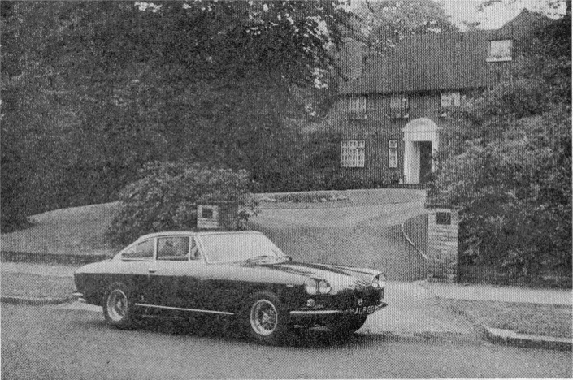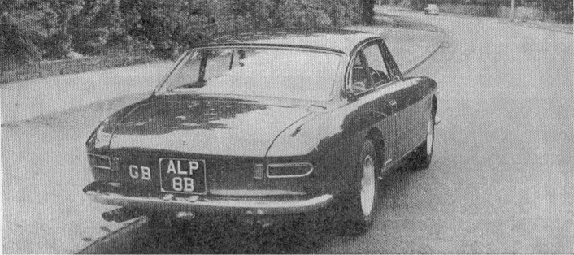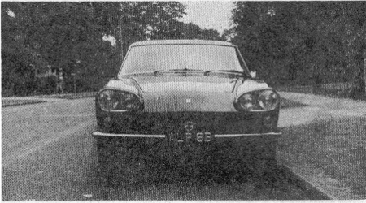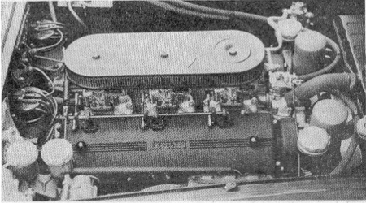 | 330 GT Registry |  |
AUTOSPORT, AUGUST 28, 1964

| Classic Moderns—No. 2 | FERRARI 330GT 2+2, latest addition to the Maranello range. |
FERRARI’S FABULOUS 330GT
By GREGOR GRANT
The 250GT Ferrari was (and still is) one of the world really great cars. Its immediate successor, the 330GT, is an even greater vehicle, which thoroughly vindicates John Bolster’s comments to the effect that “the is no better car than the car of tomorrow”. After driving the 250GT, it would not have been believed possible to improve an already near-perfect high-performance car to the extent that has been done on this latest 4-litre version of the 2+2. When Col. Ronnie Hoare, boss man of Maranello Concessionaires, offered to lend me his demonstration car for a long weekend, I naturally jumped at the opportunity.
|
FOUR-HEADLAMP treatment on the Pininfarina body is most effective (above). |
|
The car is one of the first right-hand-drive 330GTs to be imported, and from the front, and in side section, it looks every inch a Ferrari, and a tribute to the genius of Pininfarina. Nevertheless, from the rear it does not quite have that distinctive appearance one normally associates with Maranello, and one feels that the great designer could have produced something less prosaic, and more in keeping with the traditions of the Prancing Horse. I have only one more criticism, and that refers to the facia panel treatment. This attempts to follow the wood finish found on the more expensive British cars, but the result is, to say the least, a somewhat inferior imitation.
As for the rest of the car, it is impossible to avoid superlatives. The V12 engine is turbine-like in its smoothness, and in its torque. This is a car which can be trickled along in top gear at walking pace without a sign of snatch, or driven as far as road conditions will permit. Coupled with one of the most efficient synchromesh gearboxes in existence, and certainly a power-output of over 300 b.h.p., this 330GT possesses acceleration extraordinary—and in reasonable silence.
In the past, one took a certain amount of mechanical noise as inevitable with a fairly high-revving Vl2 unit. However, by increasing the capacity from 3 to 4 litre, maximum power comes in at a much lower rev. range, there has been close attention paid to exhaust silencing, and wind noise, if anything, is on a much lower level than any of the 250GT models. The tyres (Pirelli Cinturatos) were certainly audible, but have excellent road-adhering properties. The car is certainly not quite in the tradition of Rolls-Royce and some of the better American vehicles as regards mechanical silence. One feels that “Silent-travel” treatment would be highly advantageous!
Steering was so light as to be uncanny. It was something of a surprise to learn that this was power for there was not the slightest trace of deadness, the wheel at all times feeling very much alive, and entirely responsive.
The Dunlop disc brakes, with servo assistance, are ultra-efficient, and seemingly impossible to cause to fade. Some of the earlier 250s had somewhat irregular retardation, but this appears to have been cured on the 4-litre car.
Now, as regards performance, the 330GT has a maximum speed in excess of 150 mph. With no opportunity to calibrate the speedometer, nor to arrange for the necessary measured distances, I had to be content to calculate speeds in the gears from r.p.m. readings on an instrument which I was assured was dead accurate. Highest speed recorded in fourth gear (4.25 to 1 axle, 205 X 15 tyres) was 128.25 m.p.h. (6,800 r.p.m.), and in overdrive 152 m.p.h. (6,400 r.p.m.). Not wishing to “go into the red”, which happened only once when I was in fourth gear, I took the remaining three ratios at exactly 6,500 r.p.m., giving speeds of 48 m.p.h. (first), 72 m.p.h. (second), and 98 mph. (third). A swinging speedometer needle precluded taking even approximate acceleration figures, but, even so, these would have been entirely misleading on an uncalibrated instrument.
Normally speaking, anyone who can afford to buy a Ferrari does not have to worry overmuch about petrol consumption. Nevertheless, the 330GT was by no means as thirsty as one would expect, averaging about 18 m.p.g. while it was in my hands. With its 20 gallon tank, the Ferrari has a fairly useful range.
The Ferrari rear suspension must surely be the ultimate as regards a rigid axle and the classic semi-elliptic springs, the latter being assisted by additional helical springs and hydraulic dampers. Fore and after radius rods are fitted. The front is by helical springs and wishbones, controlled by telescopic dampers and an anti-roll bar. A tubular frame is used.
A single chain-driven overhead cam shaft operates the valves in each bank via roller follower rockers: the crank shaft is supported in seven bearings, and the connecting rods are coupled in pairs, running in Vandervell thinwall bearings. Crankcase and cylinder blocks are cast in silumin alloy, with shrunk-in steel liners. Twin Marelli distributors are driven from the rear of the cam shafts, and a mechanical petrol pump is supplemented by a manually controlled electric unit. Three double-choke Weber carburetters are employed; cooling is assisted by a thermostatically controlled Veglia electric fan of Peugeot origin. The cylinder heads are fully hemi-spherical, the blocks being at an angle of 60 deg.
The engine itself is of 3,967.44 c.c. (77 X 71 mm.), and with the standard 8.8 to 1 compression ratio develops 300 b.h.p. at 6,600 r.p.m. It ticks over steadily at 600 r.p.m. and proved to be a first-time starter, with the advantage of speedy warming-up.
Seating is luxurious by any standards, and the car tried had fully reclining components, of Reutter pattern. It is now possible to accommodate two adults in the rear, the latest 2+2 living up to its nomenclature, and not being designed for legless dwarfs.
Above all, the 330GT Ferrari is a delight to drive. There is a fascination about a Vl2 engine which is difficult to describe, beyond the fact that one feels that over 20 years of experience with this type of power-unit has resulted in a thoroughly reliable and dependable engine, designed specifically to run for thousands of miles without attention. In the early days it was said that Ferraris were supplied with mechanics in the tool kit, but this is certainly not applicable to the modern versions which have put the name Ferrari top of the prestige parade. It is refreshing to realize that, in this age of mass production and automation, there is still room for craftsmen who are completely dedicated to their job, with one object in view, to ensure that their products are built to the most exacting engineering standards.
To own a Ferrari is to be a cut above the ordinary mortal. Admittedly Enzo’s cars are expensive, but even so, to those who can afford them they are not just a status symbol, but a genuine seeking after the “best that money can buy”.
TAIL TREATMENT has been criticized as being rather commonplace for a Ferrari.

Copyright Autosport, 1964
Published with permission from Autosport


